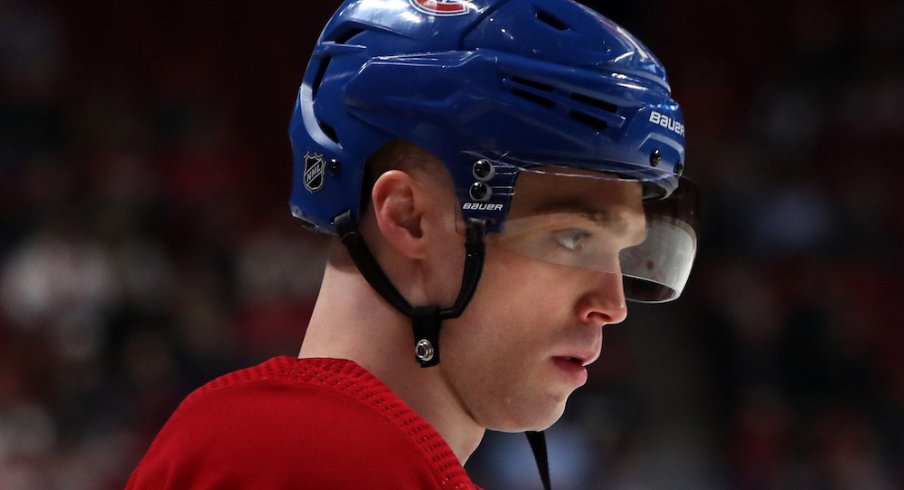When a player joins a new team, often the first point of evaluation is how many points did she or he score because we haven’t always had a chance to take in a lot of what the player can do with our eyes.
So with Max Domi joining the Columbus Blue Jackets, how do we answer the question of “how good will he be?”
There’s plenty of time to pore over video and find more and more nuance, but let’s take a first pass at what kind of player Max Domi is by testing the eye test with the data. I reached out to Laura Saba, co-host of the Locked on Canadiens podcast and asked her for two pieces of information: what are two of the best things about Domi’s game, and what are two of the biggest liabilities?
Here’s how she answered, and also how the numbers align.
Excellent play driver, generates good chances
Although last season was a down year for Domi in terms of points, it was one of his best in terms of offensive creation both individually and in terms of helping his team. According to Evolving Hockey, this year, in five-on-five adjusted play, Domi generated career highs in individual shot attempts per 60 (15.19) and individual shot quality (0.8 expected goals / 60).
At a team level, the Habs took 52.41-percent of all shot attempts when Domi was on the ice. If you compare that to last year’s Columbus roster, only Oliver Bjorkstrand fared better in terms of generating volume, and in terms of offensive quality, Domi would have fallen in the top 10 of all Blue Jackets this past season with the same performance.
And let’s dig into that play driving aspect. We see the results of what’s happening in the offensive zone in the numbers above, but what else is Domi doing to “create?”
The element that makes this trade about more than comparing the traded Josh Anderson to Domi is the positional flexibility that the latter brings to the Blue Jackets. Part of Domi’s reported frustration in Montreal was not being able to play higher up in the lineup in his preferred position: center. Conveniently, that’s a hole Columbus has been looking to fill.
How do Domi’s traits match up against the demands of playing in the center of the ice in Columbus?
Pierre-Luc Dubois has grown into the established 1C for the Blue Jackets. If we consider him both the definition for how a center plays in this organization as well as the measuring stick, how might Domi compare?
Using tracking data from Corey Sznajder, we can compare play beyond the standard offensive numbers. We can look at the transition game. How much work does a player do to get the puck out of the defensive zone (exits); get the puck into the offensive zone (entries): and then create offense as well as set up their teammates for shots of their own (shot assists)?
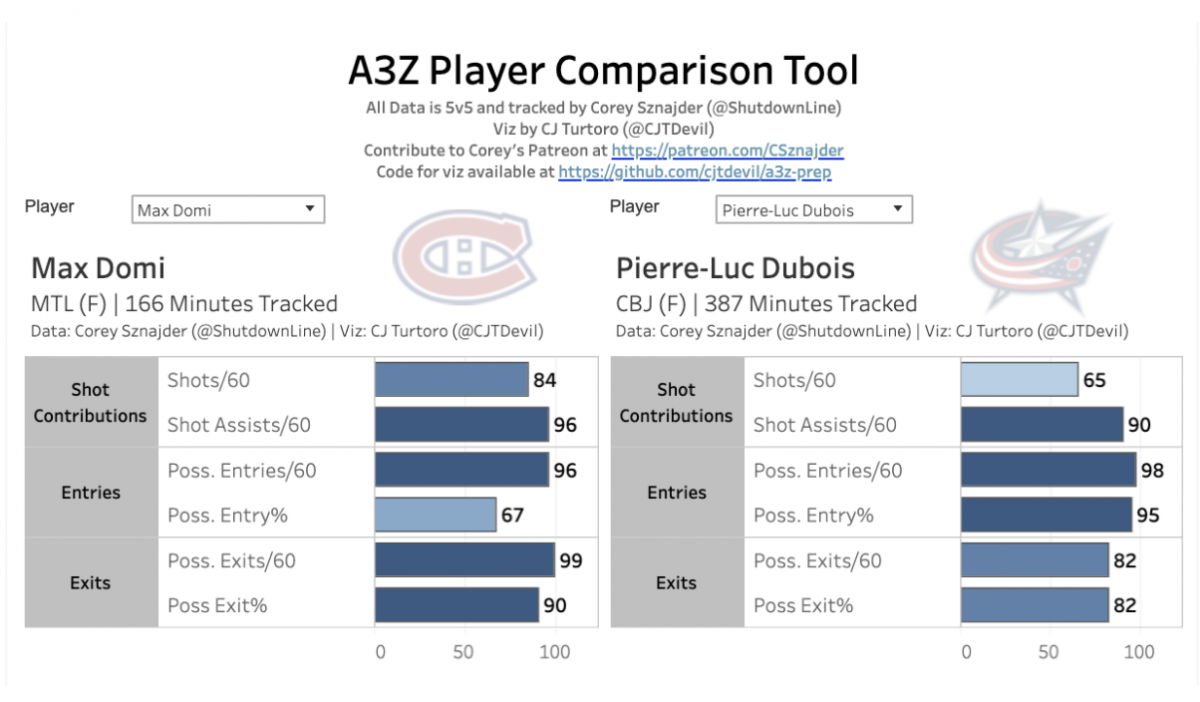 Domi looks quite good here, besting Dubois in quite a few categories with particular strengths creating offense and getting the puck out of his team’s own end. He was the strongest player on the Canadiens’ roster last season in terms of getting the puck into the offensive zone with control and once the offense was going, Domi was driving play like few other.
Domi looks quite good here, besting Dubois in quite a few categories with particular strengths creating offense and getting the puck out of his team’s own end. He was the strongest player on the Canadiens’ roster last season in terms of getting the puck into the offensive zone with control and once the offense was going, Domi was driving play like few other.
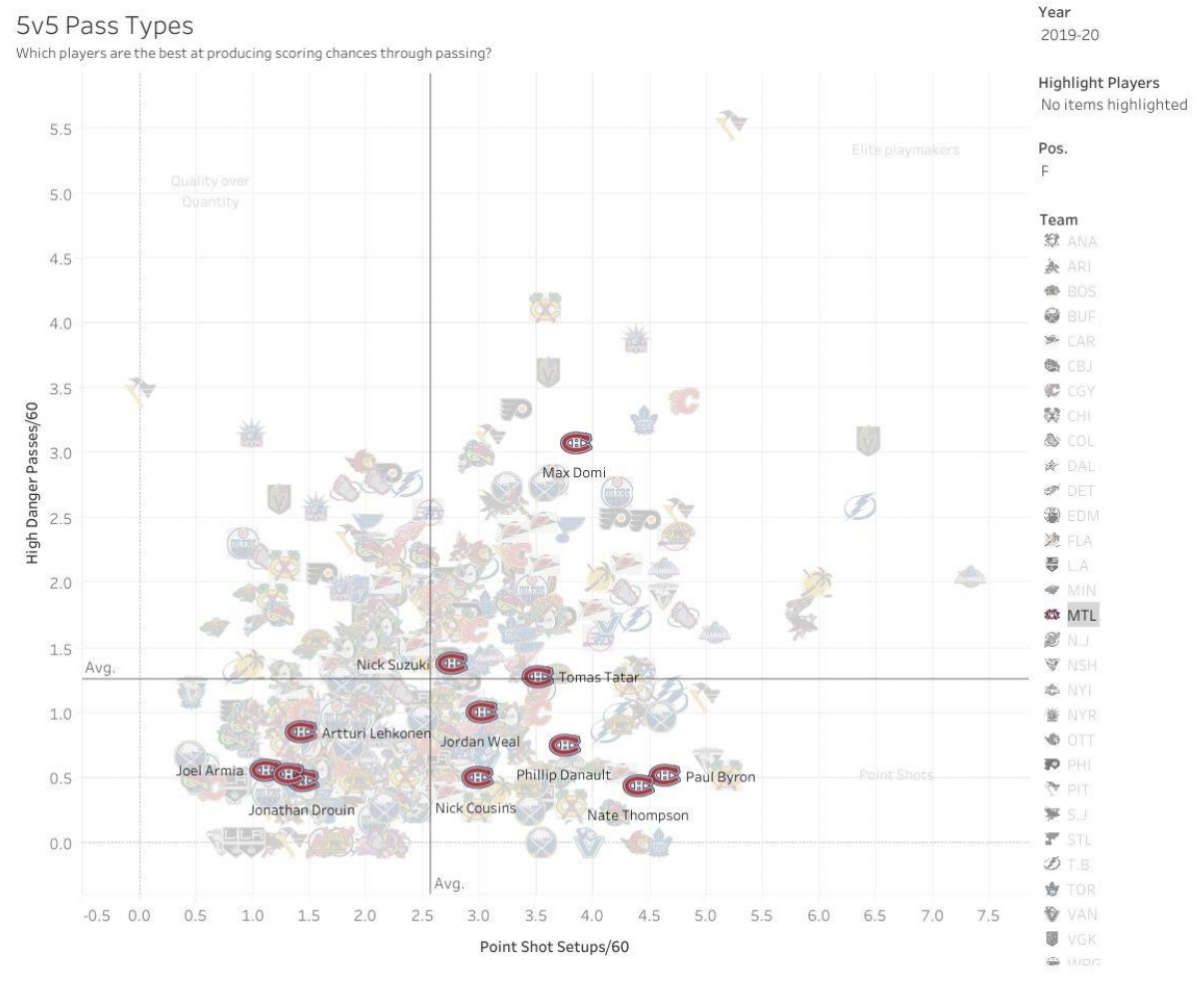
Viz courtesy Corey Sznajder (@ShutdownLine)
Look at Domi’s success getting the puck into the dangerous areas on the regular. That is something the Blue Jackets desperately need and harnessing that skill would be quite valuable to a team that struggled offensively.
Dynamic speed, tough to defend against
Saba’s second point focused on Domi’s pace and ability to confound defenders. Much of the that overlaps with what we talked about above in terms of being able to move the puck in the face of the opposition, and, since we don’t have tracking data available publicly, our eyes have to do the work for us here.
It’s certainly worth acknowledging that matching speed for speed with the loss of Josh Anderson is an important part of the puzzle for Columbus.
Now, what about the flip side? What is there to be wary of in Domi’s game?
Defensive weaknesses
Saba noted that Domi’s defensive play has improved slightly over the years but, “that’s as far as he’s going to go.”
The numbers support what eyes have seen. It is worth noting that even though Domi had a career best 2.37 expected goals against per 60 last season, among current Blue Jackets, the only player to do more poorly was Boone Jenner (2.79 xGA per 60).
Looking at the big picture, we can use Evolving Hockey’s regularized adjusted plus-minus (RAPM), to see Domi’s offensive upside but lagging defensive impact. The chart below shows Domi’s impact over the past three years in goal creation, shot quality, shot creation, oppressing opponents’ shot quality, and suppressing opponents’ shot volume.
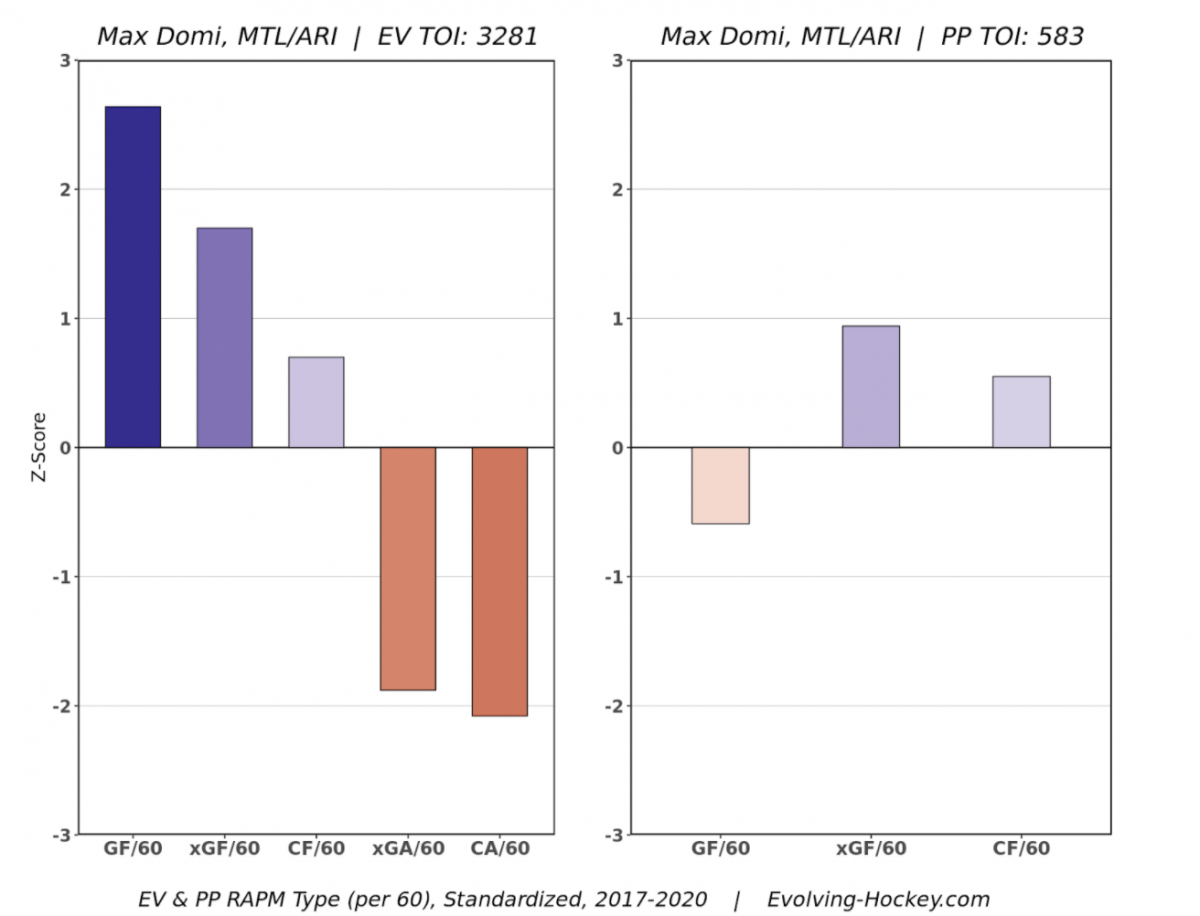
The tradeoff for offensive creation costs you defensive impact, but there’s the opportunity for that side of Domi’s game to mature under John Tortorella’s systems, or, there’s simply the challenge to be utilized correctly.
Not great at Face-offs
Saba is careful to clarify that Domi isn’t abjectly bad at face-offs, he’s just not great. Last season in five-on-five play, he was minus-18 in face-offs. However, when you consider that only Boone Jenner (plus-120), and Gustav Nyquist (plus-1 in limited use) were above breakeven on the dot, well…context matters.
In Summary
How do you best utilize Domi’s strengths while minimizing his weaknesses? Saba has an answer, “you want him on the ice at even strength and when you’re trying to even up the score if you’re down, and you do not want him on the ice when defending a lead or on the penalty kill.”
That sounds like a player filling needs Columbus has while not mucking up the works otherwise. Domi’s career has been on an upward trajectory overall – now it’s up to him and his new team to maintain that trend going forward.
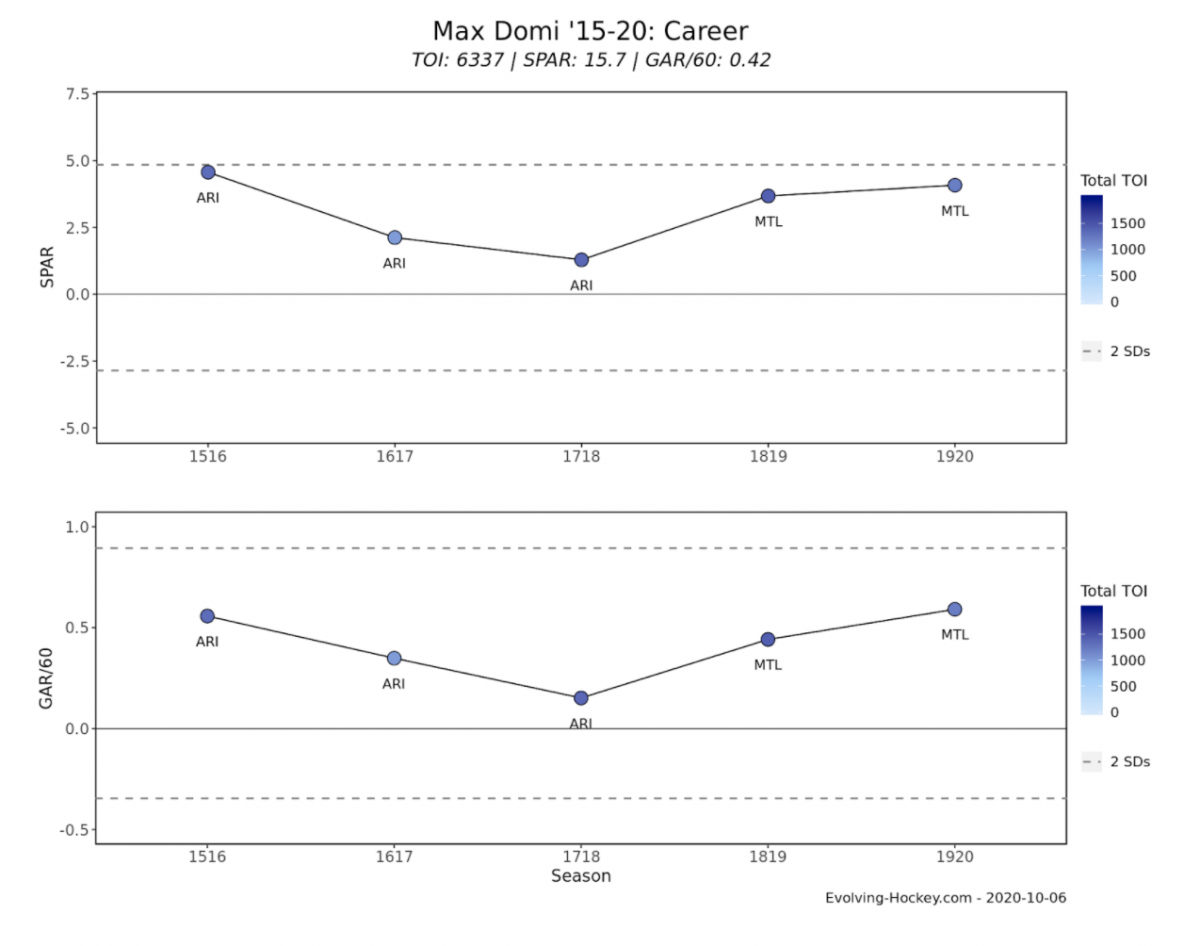
All data via Corey Sznajder and Evolving-Hockey.com unless otherwise stated.
